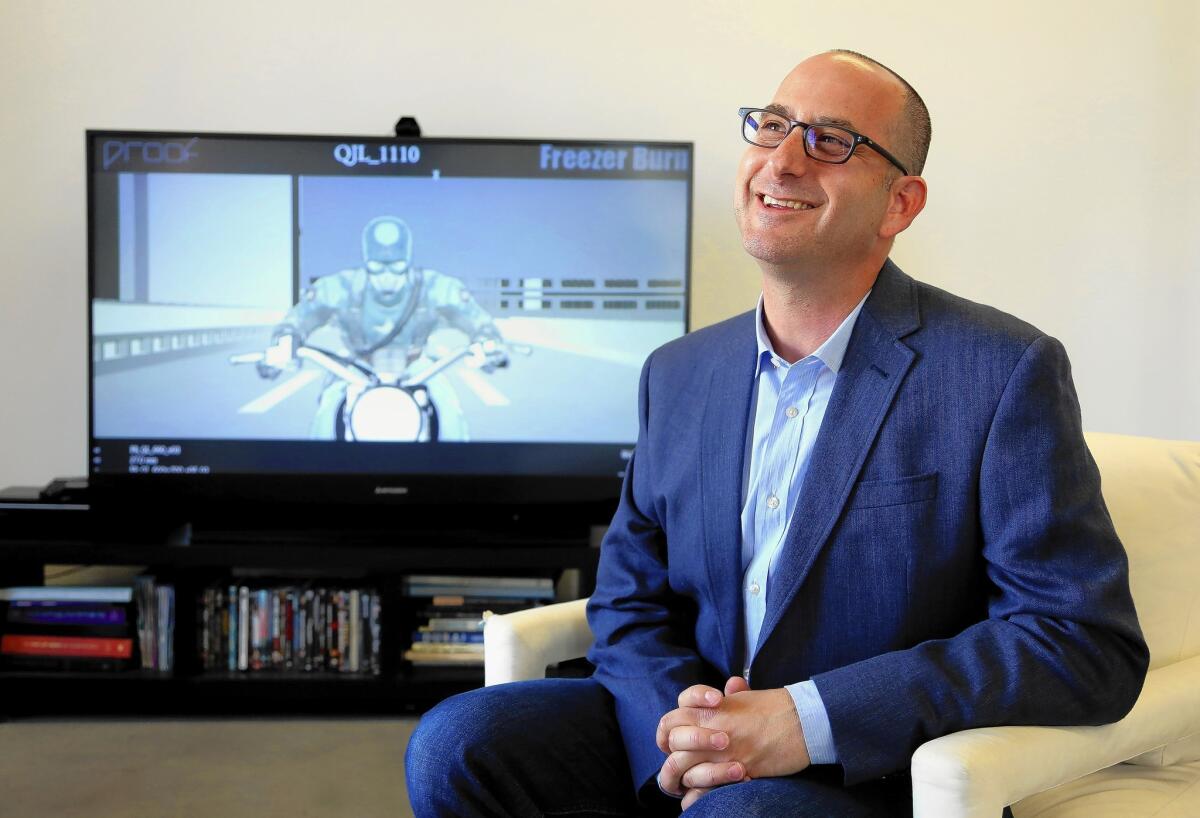Previsualization firm Proof helps filmmakers plan for complex scenes

- Share via
Before filming a massive battle on a freeway overpass in Cleveland, directors of Marvel Entertainment’s recent release “Captain America: The Winter Soldier” didn’t leave anything to chance.
So Anthony and Joe Russo staged a kind of digital dress rehearsal for the scene, planning the entire action sequence — including the position of stunt performers, the placement of explosive squibs and the types of camera lenses that would be used — on a computer screen.
They did so with the help of Proof Inc., a Los Angeles company that specializes in a process known as previsualization. The company uses computer graphics and 3-D animation software to help filmmakers see preliminary versions of shots or sequences before they film on location.
ON LOCATION: Where the cameras roll
As the cost of movies escalates with increasingly elaborate digital effects, major Hollywood studios such as Disney-owned Marvel are increasingly relying on the process to plan complex shots. The process can potentially save millions of dollars in testing scenes that might end up on the cutting room floor because they were unnecessary or didn’t work.
A decade ago, previsualization, or previs, as it is commonly known, might have been used to plan a single tricky scene. Today, the process can involve as much as two-thirds of a major action movie like “Captain America: The Winter Soldier,” which debuted last weekend and was the biggest box-office opening this year.
The trend has been a boon to Proof, which employs as many as 70 digital artists. In the last two years, sales have more than doubled, reaching about $4 million a year, said founder Ron Frankel. To keep pace with growth, the company has opened offices in Sydney, Australia, and London, where many big action movies shoot to take advantage of generous production rebates.
“The previs industry has exploded almost exponentially in the terms of the scope of work we’re touching,” said Frankel, who describes the technology as a development tool that gives filmmakers a reality check before the cameras roll.
PHOTOS: Box office top 10 of 2013 | Biggest flops of 2013
Frankel, who has a master’s degree in architecture from the Massachusetts Institute of Technology, intended to design buildings for a living. But he switched careers when he joined a classmate in New York start-up Pixel Liberation Front, which applied the computer modeling used in designing buildings to film and TV sets.
“A lot of early previs came out of architecture because you learn design process, which is really tough to explain to people,” Frankel said.
After working on various movies including “Starship Troopers” and David Fincher’s “Fight Club,” Frankel moved to Los Angeles and launched Proof in 2002. The goal was to use previsualization to help filmmakers not only plan complex visual effects, but also to design sets and coordinate stunts.
Proof typically helps directors identify what won’t work. “We like to say our greatest successes are our failures,” Frankel said.
For example, director Steven Spielberg chose to scrap most of a foot chase scene in the 2002 film “Minority Report” after watching a dozen versions of the sequence that Frankel’s team had prepared, saving about $1 million that could be spent elsewhere on the film. Similarly, a draw-bridge battle scene was scrapped from “Captain America: The Winter Soldier” after it was deemed unworkable.
FACES TO WATCH 2014: Digital media
Proof technicians get involved in the beginning of the planning process, using images from storyboard artists and consulting with the art director. Then, they build computer models of what the story and characters look like in motion. Set directors can watch the scenes to figure out how to build sets, camera operators can plan where to position equipment, and directors can visualize what shots will look like from various angles and lenses.
The process costs $35,000 to $500,000 or more, depending on the project size.
“It’s like an insurance policy,” Frankel said. “You can shoot the scene knowing it will work, then spend time embellishing and improving it. Or you can leave a shot on the editing room floor because you realize it won’t work and it would have been money wasted to film it.”
The company works on 20 to 30 films a year. Current projects include “Fast & Furious 7,” “Night at the Museum 3” and another upcoming Marvel project, “Guardians of the Galaxy.”
“Captain America: The Winter Soldier” was the company’s biggest project to date. Proof spent 18 months working with the filmmakers to plan key scenes of the movie starring Chris Evans and Scarlett Johansson. They also worked closely with the director during production itself to provide on-set visualization of scenes.
“The Proof team and I were involved very early on in the planning of this film,” said Marvel’s Dan DeLeeuw, visual effects supervisor on the film. “Any time I suggested an idea, they’d show me several variations on that idea in just a mere few hours. They are terrific at delivering fine, fantastic images.”
More to Read
From the Oscars to the Emmys.
Get the Envelope newsletter for exclusive awards season coverage, behind-the-scenes stories from the Envelope podcast and columnist Glenn Whipp’s must-read analysis.
You may occasionally receive promotional content from the Los Angeles Times.











